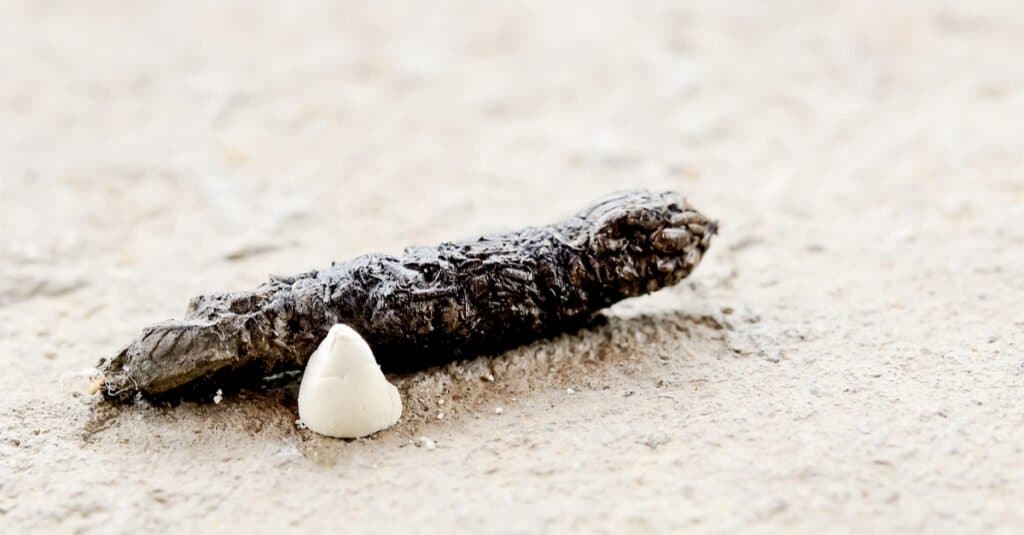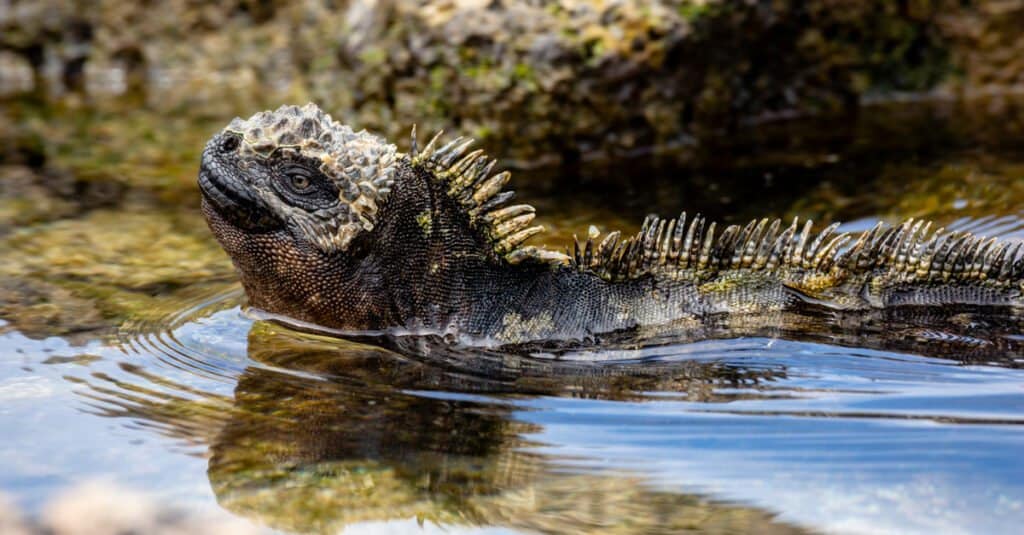Poop: every animal produces it in some form or another, even our scaly friends like snakes and lizards! But what does lizard poop look like? Perhaps you’re trying to identify some unpleasant droppings in your garden. Maybe you want to know if your own pet lizard’s waste looks healthy. Either way, let’s take a look at all those smelly questions you have (but have maybe been afraid to ask) about lizard poop, how they poop, and more. Just what you always wanted, here is a look at lizard poop pictures!
What Does Lizard Poop Look Like?

A lizard poop picture: Lizard’s poop looks like a long black pellet with a semi-white cap at the end.
©saodaeng/Shutterstock.com
Lizard poop, it turns out, has a very distinct appearance— one you’re likely not to forget once you’ve seen it. It typically has a long brown or black pellet-shaped portion with a smaller, semi-solid white “cap” or substance at the end. While the brown portion is the lizard’s poop, the white part is essentially the lizard’s urine.
The reason why lizard poo has such an easily identifiable look is because of the unique way these reptiles expel their waste.
Most mammals like humans, apes, dogs, rodents, and many more excrete their feces and urine separately. They have two dedicated openings for getting rid of feces and urine, respectively.
However, other animals like lizards and birds essentially poop and pee at the same time from the same opening. They have one opening, the cloaca, that is used for expelling both types of waste. Reptiles and birds also use their cloacae for reproduction. Oddly enough, some reptiles like aquatic turtles even use their cloacae to breathe while swimming underwater with the help of an additional air bladder!
Since lizards get rid of their poo and pee all in one go, their urine (or uric acid, in this case) appears as the white stuff in their feces. You’ve probably noticed bird poo has a somewhat similar, if smaller and less solid, appearance. This is because they, too, use their cloacae to eliminate their feces and urine at the same time. Rather than a single white “cap” at the end, though, bird poo tends to be a more amorphous mixture of the two substances.
How Often Do Lizards Poop?

A lizard’s diet, among many other factors, affects how often it poops.
©Susan Schmitz/Shutterstock.com
Exactly how often a lizard poops will depend heavily on their species, size, habitat, and specific diet. Different types of lizards have different healthy ranges for how often they should poop.
Size is a key determinant of how often a lizard will defecate. For example, smaller lizards like geckos typically poop every day to every other day. Larger lizards like varanids (monitor lizards) may only defecate once or twice per week. Something in the middle size-wise, like a bearded dragon or a slightly larger iguana, will poop every other day or so.
Diet is another important factor. Herbivorous lizards generally produce more feces per meal than carnivorous or omnivorous lizards. This is because herbivores eat larger quantities of food than carnivorous animals. As a result, carnivorous lizards will produce less poo than herbivores, as well as smaller amounts of it overall. Meat digests faster and more efficiently than plant material.
This means, for example, a herbivorous green iguana will usually poo more often and in larger amounts than a more omnivorous rhinoceros iguana of around the same size.
Habitat and environmental conditions can also affect how often a lizard poops. Fluctuating temperature and humidity levels can either stimulate a lizard’s bowels more easily or make things, well, a bit more challenging from time to time. Depending on the weather conditions, a certain species may have more or less access to water than usual.
In short, there are a lot of different factors that can contribute to how often a lizard should poop. If you’re curious about your own pet lizard’s ideal pooping schedule, it’s best to research their specific species. This will give you a better idea of how much and how often they should defecate on average.
Why Do Lizards Always Poop in Water?

Many iguanas, such as this
marine iguana
, enjoy soaking their bodies in water to stimulate their bowels.
©buteo/Shutterstock.com
If you have a pet lizard or have ever observed them in captivity, you’ve likely noticed the moment they soak their bodies in water, they tend to defecate. There are a couple of main reasons for this:
- Water, especially warmer water, helps to stimulate their bowels.
- Lizards are used to soaking their bodies in and drinking from the same water source in the wild.
You’ve likely noticed a warm bath soothes your stomach if you’re ill or having digestive issues, and the same goes for lizards! Warm water is simply comforting to soak in for lizards, especially if they’re constipated. The water eases things along so they are more easily able to pass their waste without any painful difficulty.
Additionally, for captive lizards, it is very common for them to have two separate water sources: a larger one for bathing and a smaller one for drinking. This makes cleanup a lot easier and prevents your pet lizard from ingesting harmful bacteria. In the wild, however, lizards tend to take water wherever they can get it, using it for both drinking and bathing if they can.
Other possible theories have more to do with evading predators. Some researchers have posited that lizards poo in water to help mask their scent. Either way, the behavior is normal and very common amongst virtually all species of lizards.
How Do I Know What Animal Poops in My Yard?
Animal droppings can be encountered in various places, whether it’s in your home, such as your garden or outbuildings, or when you’re out in the countryside.
To identify them, make a record of their size, shape, and color, and gently break them apart using a stick to examine their contents. However, always avoid direct contact, as they may harbor harmful bacteria.
Furthermore, mammals such as raccoons have an even broader geographic distribution than foxes and are as abundant as deflated Mylar balloons. They have a tendency to deposit their feces in designated raccoon “latrines,” consistently using the same location over extended periods.
In natural habitats, they prefer spots like the bases of trees, tree forks, or elevated areas such as fallen trees.
The photo featured at the top of this post is © reptiles4all/Shutterstock.com
Thank you for reading! Have some feedback for us? Contact the AZ Animals editorial team.







